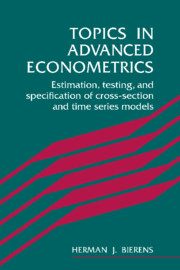 Topics in Advanced Econometrics
Topics in Advanced Econometrics Book contents
- Frontmatter
- Contents
- Preface
- 1 Basic probability theory
- 2 Convergence
- 3 Introduction to conditioning
- 4 Nonliner parametric regression analysis and maximum likelihood theory
- 5 Tests for model misspecification
- 6 Conditioning and dependence
- 7 Functional specification of time series models
- 8 ARMAX models: estimation and testing
- 9 Unit roots and cointegration
- 10 The Nadaraya–Watson kernel regression function estimator
- References
- Index
5 - Tests for model misspecification
Published online by Cambridge University Press: 28 October 2009
- Frontmatter
- Contents
- Preface
- 1 Basic probability theory
- 2 Convergence
- 3 Introduction to conditioning
- 4 Nonliner parametric regression analysis and maximum likelihood theory
- 5 Tests for model misspecification
- 6 Conditioning and dependence
- 7 Functional specification of time series models
- 8 ARMAX models: estimation and testing
- 9 Unit roots and cointegration
- 10 The Nadaraya–Watson kernel regression function estimator
- References
- Index
Summary
In the literature on model specification testing two trends can be distinguished. One trend consists of tests using one or more well-specified non-nested alternative specifications. See Cox (1961, 1962), Atkinson (1969, 1970), Quandt (1974), Pereira (1977, 1978), Pesaran and Deaton (1978), Davidson and MacKinnon (1981), among others. The other trend consists of tests of the orthogonality condition, i.e. the condition that the conditional expectation of the error relative to the regressors equals zero a.s., without employing a well-specified alternative. Notable work on this problem has been done by Ramsey (1969, 1970), Hausman (1978), White (1981), Holly (1982), Bierens (1982, 1991a), Newey (1985), and Tauchen (1985), among others.
A pair of models is called non-nested if it is not possible to construct one model out of the other by fixing some parameters. The non-nested models considered in the literature usually have different vectors of regressors, for testing non-nested models with common regressors makes no sense. In the latter case one may simply choose the model with the minimum estimated error variance, and this choice will be consistent in the sense that the probability that we pick the wrong model converges to zero. A serious point overlooked by virtually all authors is that nonnested models with different sets of regressors may all be correct. This is obvious if the dependent variable and all the regressors involved are jointly normally distributed and the non-nested models are all linear, for conditional expectations on the basis of jointly normally distributed random variables are always linear functions of the conditioning variables.
Information
- Type
- Chapter
- Information
- Topics in Advanced EconometricsEstimation, Testing, and Specification of Cross-Section and Time Series Models, pp. 89 - 109Publisher: Cambridge University PressPrint publication year: 1994